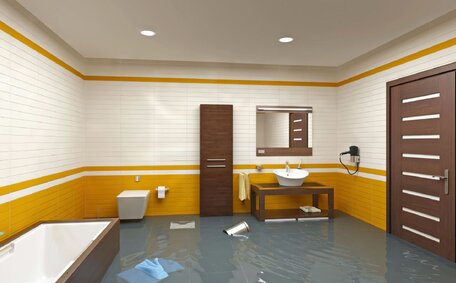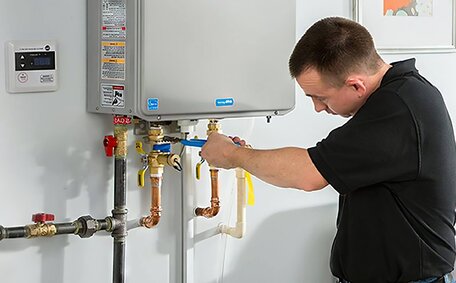
Signs Your Hot Water System Is Failing
Common signs your hot water system is failing include strange noises, rust, leaks, inconsistent temperature and pressure. Call our licensed plumbers if you notice these issues for repairs.
Read MoreA clogged drain is a common yet frustrating plumbing issue that most homeowners will encounter at some point. When simple drain cleaners and plungers don’t get the job done, there are two more powerful methods that plumbers use to clear stubborn blockages: drain snakes (also called augers or plumbing snakes) and hydrojetting.
A drain snake, or plumber’s snake, is a long, flexible coiled cable that can be inserted down the drain and rotated to physically break up and hook debris that is clogging the pipe.
Hydrojetting involves shooting a highly-pressurised stream of water through the drain to scour and dislodge the blockage. Both techniques have their advantages and downsides.
Drain snakes tend to be simpler, cheaper, and less likely to damage pipes. However, they are not as thorough and often cannot clear very stubborn obstructions like tree roots. Hydrojetting has superior scouring action but works best when performed by professionals as the high water pressure can potentially damage pipes if not done properly.
This article provides an overview of how both drain cleaning methods work, when each should be used, as well as the key pros and cons to consider when dealing with a seriously clogged drain. With this information, readers can make an informed decision on the best solution for their particular plumbing dilemma.
Drain snakes, also known as plumbing augers or flexi-shafts, work by physically breaking up and removing blockages inside pipes. They consist of a long, flexible metal coil that is wound around a drum and fed manually into the drain opening.
To clear a clogged drain, the plumber first feeds the snake into the pipe, using the twist of the coil to work it around bends. The snake is pushed forward and the end is rotated, which allows the coil to grab onto built-up gunk, hair, and other debris snagged in the pipe.
As the snake is retrieved, the hooked debris is broken up and pulled out, effectively scrubbing the drain interior and removing the clog.
Drain snakes come in different sizes - smaller ones for sinks, shower and tub drains, and larger ones (up to 100 feet long!) for main sewer lines.
A flexible 3/8 inch coil is used for tight spots, while a 1/4 inch coil provides more strength for long runs. The snake diameter and length are chosen according to pipe size and estimated clog location.
Snakes work well for clearing minor clogs and soft obstructions like grease, soap build-up, food particles, and other organic matter. However, they are less effective against very stubborn blockages like tree roots or mineral deposits. Overall, drain snakes provide a simple, low-cost way to maintain and clear drains.
Drain snakes have several advantages over hydrojetting:
The bottom line is that for minor clogs, drain snakes provide an affordable, user-friendly solution. They make an excellent first response before calling in the pros with hydrojetting equipment.
While drain snakes are very useful for minor clogs, they do have some disadvantages compared to hydrojetting:
For these reasons, hydrojetting is recommended over augers for severe clogs or those involving grease, roots, or complete blockages. However, for minor sink clogs, drain snakes remain a handy first line of defence.
Hydrojetting uses an intense, highly-pressurised stream of water to clear blockages and scour the inside of pipes. Specialist hydrojetting equipment generates up to 4000 PSI (pounds per square inch) of water pressure that gets expelled through a narrow nozzle at the end of a hose.
To hydrojet a drain line, the hose nozzle is lowered into the pipe access point, like a cleanout or roof vent. High-velocity water is then pumped through the hose and jetted out of the nozzle. This creates a physical force that propels the nozzle forward through the pipe, bombarding and cutting through any buildup.
As the nozzle advances, the pressurised water stream scrubs the pipe walls and breaks up debris, grease, and even tree roots. The debris gets flushed down the pipes and washed out of the drainage system.
the water pressure, hydrojet hoses have a rear-facing nozzle that propels the hose forward without the operator needing to physically push from the access point. This allows the hose to get far down pipes and around bends.
Hydrojetting requires experienced professionals to evaluate drainage layouts and operate the complex equipment safely. But in experienced hands, it is an extremely effective method for clearing severely clogged drains beyond what regular drain snakes can handle.
Hydrojetting has several key advantages that make it the superior choice over drain snakes for severe or challenging clogs:
While hydrojetting requires professional equipment and expertise, it is virtually unrivalled for clearing blocked drains, improving drainage, and restoring pipe function. Hydrojetting should be considered whenever regular snakes fail to resolve a stubborn clog.
While an effective drain cleaning method, hydrojetting has some potential drawbacks to be aware of:
Homeowners should carefully consider the condition of their pipes before using hydrojetting. For minor household clogs, a standard drain snake is often the safer and more cost-effective solution.
Choosing between using a drain snake or hydrojetting often comes down to the severity and location of the clog:
For serious sewer line clogs or backups on the main property line, hydrojetting delivered fast, superior results. But for routine maintenance and minor clogs, a hand auger is often the best DIY solution.
While hydrojetting is an extremely effective drain cleaning method, the high water pressures involved make it imperative that only licenced, professional plumbers perform the service.
Hydrojet systems operate at up to 4000 PSI of water pressure, which allows their nozzles to cut through even the most stubborn drain clogs. However, those intense pressures also carry risks if proper procedures are not followed.
Improper hydrojetting technique could potentially damage pipes, cause leaks and flooding, spray dirty water everywhere, and harm operators or bystanders if the hose whipped around uncontrolled. Technicians must understand drainage layouts to avoid hydrojetting in the wrong direction.
Leave hydrojetting for professionals with extensive equipment training who follow safety protocols. They will have the skills to diagnose drain issues, set up equipment safely both indoors and outdoors, operate the high-pressure jets responsibly, and clean up properly afterwards.
While the process comes at a higher cost than DIY drain cleaning, hydrojetting is extremely effective when performed correctly by qualified plumbers. Don’t take risks - professional hydrojetting services are the safest option for tough clog removal.
At Marrickville Plumbing, we are fully licenced professional plumbers equipped to handle any drain issue - whether it is a minor sink clog or major blockage requiring hydrojetting services. Don’t waste time and money trying to DIY remedies that may potentially damage your pipes or fail to resolve the problem.
Our expert team has the knowledge and tools to accurately diagnose your drain clog, and we will recommend the most effective and safest solution. We are local to the Marrickville area and can respond promptly for emergency calls. You can trust our certified plumbers to resolve any persistent drain or sewer line blockage.
For professional hydrojetting or snake drain services in Marrickville, contact our team today. We offer competitive rates with no call out fees. Get in touch by phone on 1300 1234 5678 or email us at jobs@marrickvilleplumbingservices.com.au - we look forward to restoring proper drainage to your home or business.
Common signs your hot water system is failing include strange noises, rust, leaks, inconsistent temperature and pressure. Call our licensed plumbers if you notice these issues for repairs.
Read MorePipe relining is an eco-friendly alternative to pipe replacement that uses materials like epoxy resin to repair pipes without digging. It produces less waste and emissions than traditional methods. Learn about the environmental benefits of trenchless pipe relining.
Read MoreReplacing an outdated electric, gas or solar hot water system with a more efficient heat pump or solar model can significantly reduce your energy bills and carbon footprint. Take advantage of available rebates. Contact us to retrofit your old system today.
Read MoreMarrickville, 2204 NSW
We will call back as soon as possible.




